(i) Have You Seen the Swastika Stone?
We are making our way up Heber’s Ghyll, the small wooded gully that carries the waters of Black Beck down from Ilkley Moor into the valley of Wharfedale, when Paul first mentions the Swastika Stone.
I am so surprised I almost do a comedy double-take. I have never before heard of the Swastika Stone yet its mention has captured my complete attention. There’s a tingling at the back of my skull, a sense that something very significant has just occurred.
How significant I cannot say. I have no way of knowing that Paul’s innocent question will mark the start of a compelling journey, one that will take me deep into magic and symbolism and the nature of reality, uncovering a powerful mystery hidden in the landscape and history of this northern town.
It is March 2006 and I have come to Ilkley to spend the weekend with friends. I am at this time in the middle of researching an ancient and mysterious symbol. Consisting of ten spheres connected by a series of interlacing lines, it is known as the Tree of Life and it is said that it can help unlock the mysteries of the universe.
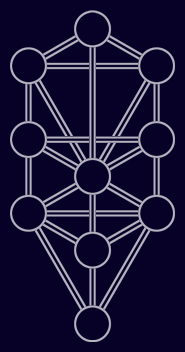
I am keen to put this claim to the test. Each sphere on the Tree has its own unique set of correspondences, creating what has been likened to a filing cabinet of symbolic ideas. Events or objects are placed depending on their qualities and attributes. Concepts of motherhood are particularly suited to one sphere, anything connected to the moon to another, while themes of nature and sexuality belong to a third.
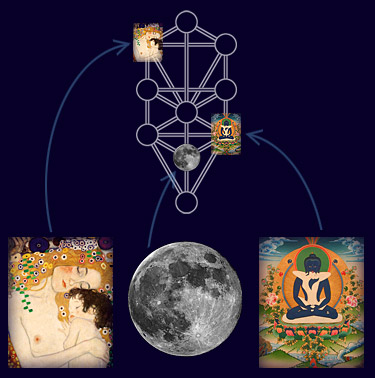
This is more than just a system of ordering information and putting data into boxes; it is a way of revealing the secrets behind surface appearances. By studying the correspondences of each of the ten spheres, I will apparently build up a framework of symbolic association that can shed light on all manner of phenomena – throwing up enchanting revelations, showing how everything interconnects and leading my mind towards a deeper understanding of the manifest world.
(WHO SAYS?) <- click to expand
I am making my way through four books on the matter:
Dion Fortune – The Mystical Qabalah
Superb introduction to the subject.
Gareth Knight – A Practical Guide to Qabalistic Symbolism volumes I & II
One or two questionable opinions (which the author addresses in a recently reprinted two-volume edition) amidst a wealth of useful information.
Dolores Ashcroft-Nowicki – The Shining Paths
A practical approach to the paths of the Tree.
The literature suggests adopting a practical approach, looking for ways in which the Tree relates to everyday life, so this is what I do. Ilkley is the end point in a road trip that zig-zags north from my home in Bristol. To see if there is an underlying connection I match the various stages to specific points on the Tree. A few interesting correlations crop up, but so far it is all fairly tenuous. Until Heber’s Ghyll, that is.
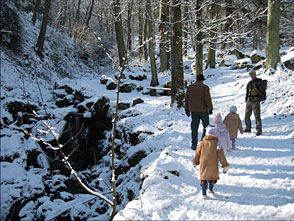
It is a bright Saturday morning in early March. An overnight fall of snow has blanketed the landscape, transforming the gully into a fairytale dell of glimmering brightness and deep shadow. Beneath us the waters tumble between snow-capped rocks and ahead the sun, hanging low over the crest of the moor, gleams brightly though the winter branches.
It will be my first time setting foot on Ilkley Moor, a place that – apart from a mention in an old campfire song – I know nothing about. As the highest point on my trip, I have decided that the climb to the moor – a literal ascent to higher ground – will symbolically represent an ascent to Kether, the highest sphere on the Tree of Life.

My companions know nothing of my mystical musings and there is no reason to tell them.
I am making the connection between the moor and the highest sphere on the Tree when Paul cuts across my thoughts with a question: “Have you seen the Swastika Stone?”
What was previously a mildly entertaining mental exercise suddenly takes on a new dimension. My attention is hooked is because Kether, the sphere I have at this very moment been thinking about, is symbolized by a Swastika.

(THE SWASTIKA – A SYMBOL OF LIFE)
For thousands of years before events in the twentieth century cast it as an emblem of hatred and intolerance, the Swastika was held to be the opposite: a symbol of vitality and peace. It can be found in traditions from all over the world - from Mithraism to Shamanism, from the Hindus to the Hopi, from ancient Greek art to early Christian design - and while different belief systems bring their own shade of meaning, the basic symbolism is universal: a positive outpouring of energy and life.

The centre represents the Source, the point of creation from which all life springs; the four arms depict the outward flow of energy, rotating as it expands in a perpetual spiral movement. The number of arms has various interpretations, including:
- The four worlds of creation
- The four cardinal directions
- The four alchemical elements – earth, air, fire and water
Taken together the four arms depict the many emanating from the One, the continuing diversity of creation. Far from being anti-life, the Swastika represents a never-ending bountiful flow. It is a celebration of life.
Years of exposure to such coincidences have taught me to pay attention. To have mentally linked the moor with Kether only to find – in the same instance – that the moor is indeed marked with a Swastika, seems like a remarkable verification. But is there a greater significance?
The teachings of the Tree support such speculation. According to tradition, there is no such thing as simple coincidence and even the most trivial of events can hold deep secrets.
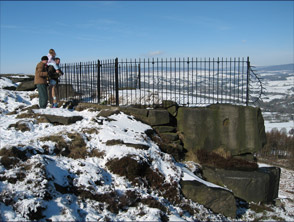
After emerging from the head of the gully onto the wild sweep of snow-covered heathland, a detour westward along the lip of the moor brings us to the buttress of rock known as the Swastika Stone.
(THE SWASTIKA STONE)
Nobody can say for sure exactly when the Swastika Stone was carved. The design suggests Celtic origins, although dating rock carvings is notoriously difficult. Some place it as far back as the Bronze Age, some suggest Iron Age, some say it was most likely carved during the time the Romans held an outpost on the banks of the River Wharfe.
Whatever the date, it would have appeared in a time when the Swastika was seen as a symbol of good fortune, rather than for the tarnished reputation it endures today.
Out of reach beyond a set of old railings, the carving is obscured, completely covered by snow. Kether is described in the texts as the Hidden Intelligence, making this veil of concealment rather appropriate. It is not the only correspondence to capture the imagination.
(CORRESPONDENCES OF THE SWASTIKA STONE)
Kether is the Fount of Creation, the Source, the point at which the universe comes into existence and from which the Lightning Flash of Creation descends through the successive spheres of the Tree of Life into denser manifestation.
Kether, the First Manifest, represents the primal crystallisation into manifestation of that which was hitherto unmanifest and therefore unknowable by us.
Dion Fortune, The Mystical Qabalah
Perched on the lip of the moor, where the land drops away into the ‘void’ of Wharfedale, the location of the Swastika Stone is well-suited to this description. In A Guide to Qabalistic Symbolism, it is said that Kether is situated right on the edge of the manifest universe, where it gives way to ‘the great unknown.’
Before the manifestation of the first Sephirah is the Unmanifest, which, through the condensation of the Cloud-Veils of Negative Existence, finally concretes Kether, the first manifest of the manifest Universe.
Gareth Knight, A Guide to Qabalistic Symbolism Volume I
The colour of Kether is brilliant white; two of its titles are “The White Head” and “Concealed of the Concealed”. The bright cloak of snow that covers the Swastika Stone fits these correspondences well.
Kether means ‘Crown.’ With a little imagination, the railings that protect the carving can be seen to resemble a crown sitting on the head of the stone.
A stretch perhaps, particularly as the so-called crown of railings is incomplete; only three of the four edges are railed. The edge that backs onto the valley is open. However, this too fits with the symbolism, for the magical image of Kether is an ancient bearded king in profile.
…we do not see the magical image of Kether full-face…there is an aspect which must be ever hidden from us, like the hidden side of the moon. This side of Kether is the side that is towards the Unmanifest…
Dion Fortune, The Mystical Qabalah
An incomplete circle of railings is therefore entirely appropriate.
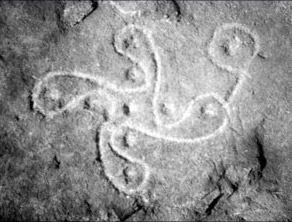
After lingering to take in the site, we retrace our route along the lip of the moor and descend the slope to the waiting cars. Back at the house, Paul shows me a photograph of the carving.
It is a fascinating design, one that throws up yet more links.
(MORE CORRESPONDENCES OF THE SWASTIKA STONE)
All three of Kether’s symbols – the Swastika, “the point” and “the point within a circle” – are captured in the carving’s design.
The carving depicts nine points emerging from a single point of origin just as the nine lower spheres on the Tree of Life emerge from the highest.
The interpretation of the nine emerging from the One is supported by a description of the carving I later find online.
The single ‘outlying’ cup from the four spiralling arms is, to me, the point from which the four-arms originated and not the other way round. In early cosmogenic patterns the world over, the worlds emerged from the round, the single, the point, or uroborous - and this is what this Swastika Stone appears to represent.
originally posted on The Modern Antiquarian website
I haven’t yet told Paul of the Swastika Stone synchronicity. It’ll take some explaining and besides, I’m still not sure what I’ve got. The pursuit of esoteric wisdom can be like the piecing together of a nebulous puzzle. Fragments appear, elusive suggestions of some deeper significance, and it is often not until later – sometimes years later – that pieces combine to create a coherent whole. At the moment I have an isolated fragment of uncertain worth.
This is about to change.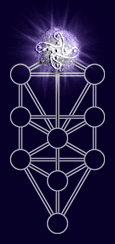

 TOP
TOP NEXT
NEXT